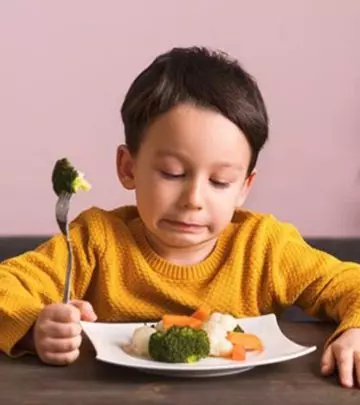
Image: iStock
Remember the times when your mom told you to finish your veggies when you were a child? You would be dreading your plate of spinach and carrots wishing your mom gave you French fries instead.
A well-balanced diet is crucial for a child’s overall growth and development. A diet which is not balanced and lacking in the essential vitamins and minerals may lead to numerous unpleasant symptoms. These symptoms let us know if our body is deficient in any nutrients. Once you know what your child is lacking, you can make the necessary changes in the diet. Here, we talk about the most common symptoms of nutritional deficiencies that you can easily figure out in a child:
1. Ulcers Or Cracks In The Mouth
If you notice any lesions in and around your kid’s mouth, it may be because of certain deficiencies. It could be linked to iron or vitamin B deficiency (1). Besides this, it can also be caused by salivating excessively or dehydration. If your kid is suffering from mouth ulcers, include foods such as dark leafy greens, seeds, nuts, meat, poultry, fish, and whole grains in their diet. Eating foods that are rich in thiamin, pyridoxine, and riboflavin is also known to alleviate the symptoms. Foods which are good sources of thiamin, pyridoxine, and riboflavin include poultry, meat, green vegetables, nuts, seeds, starchy vegetables, eggs, dairy, and organ meat.
2. Brittle Nails And Hair
Brittle hair and nails can be caused by a lack of biotin. Another name for biotin is vitamin B7 (2). Biotin deficiency can cause other symptoms such as cramps, muscle pain, chronic fatigue, etc. The risk factors for this deficiency are the continuous use of antibiotics and certain anti-seizure medicines. Foods that are good sources of biotin include fish, meat, dairy, nuts, spinach, egg yolks, sweet potatoes, bananas, and yeast.
3. Bleeding Gums
Vigorous brushing of teeth can lead to bleeding gums, but that is not the only reason for your child’s gums to bleed (3). Vitamin C deficiency is also to blame. Vitamin C helps in preventing cell damage, and also heals wounds and provides immunity. This kind of deficiency can occur in children who don’t have enough fruits and vegetables in their diet. Besides bleeding gums, it can also result in loss of teeth.
4. Hair Loss
Hair loss is common among older men and women (4). And it’s not just the age that plays a part, but the diet as well. So make sure your child gets enough of iron, zinc, niacin, biotin, linoleic acid and alpha-linolenic acid in their diet. Flax seeds, chia seeds, walnuts, whole grains, legumes, fish, meat, eggs are good sources of the above-mentioned nutrients.
5. Vision Problems
A diet that is lacking in vitamin A can cause vision problems such as night blindness and white growths on the eyes (5). Vitamin A deficiency is rarely found in developed countries. However, if your child is diagnosed with a deficiency of vitamin A, include dairy, eggs, yellow and orange-colored veggies, fish, and organ meat in their diet.
6. White Spots On Nails
If you notice white spots on your kid’s nails, it could be because of zinc or iron deficiency (6). This is one symptom that we often see in children. Make sure you include zinc and iron-rich food in your kid’s diet and see if there’s any improvement in the white spots. If the white patches are accompanied by any other symptoms, consult a doctor.
7. White/Red Bumps On Skin
Children often get red or white bumps on the skin which looks like goosebumps (7). It can appear on thighs, cheeks, arms, and buttocks. This condition is known as keratosis pilaris. It can be a hereditary condition passed on by family members or because of a deficiency caused by vitamin A and C. Consider adding more dark leafy greens, organ meats, fish, egg, dairy, and yellow-orange colored veggies and fruits in your kid’s diet.
Don’t blame yourself or feel guilty if your child develops any of the above symptoms. Make sure your child follows a nutritious diet and eats healthy. However, if you find that the symptoms are persisting, it’s best to consult a doctor.



















